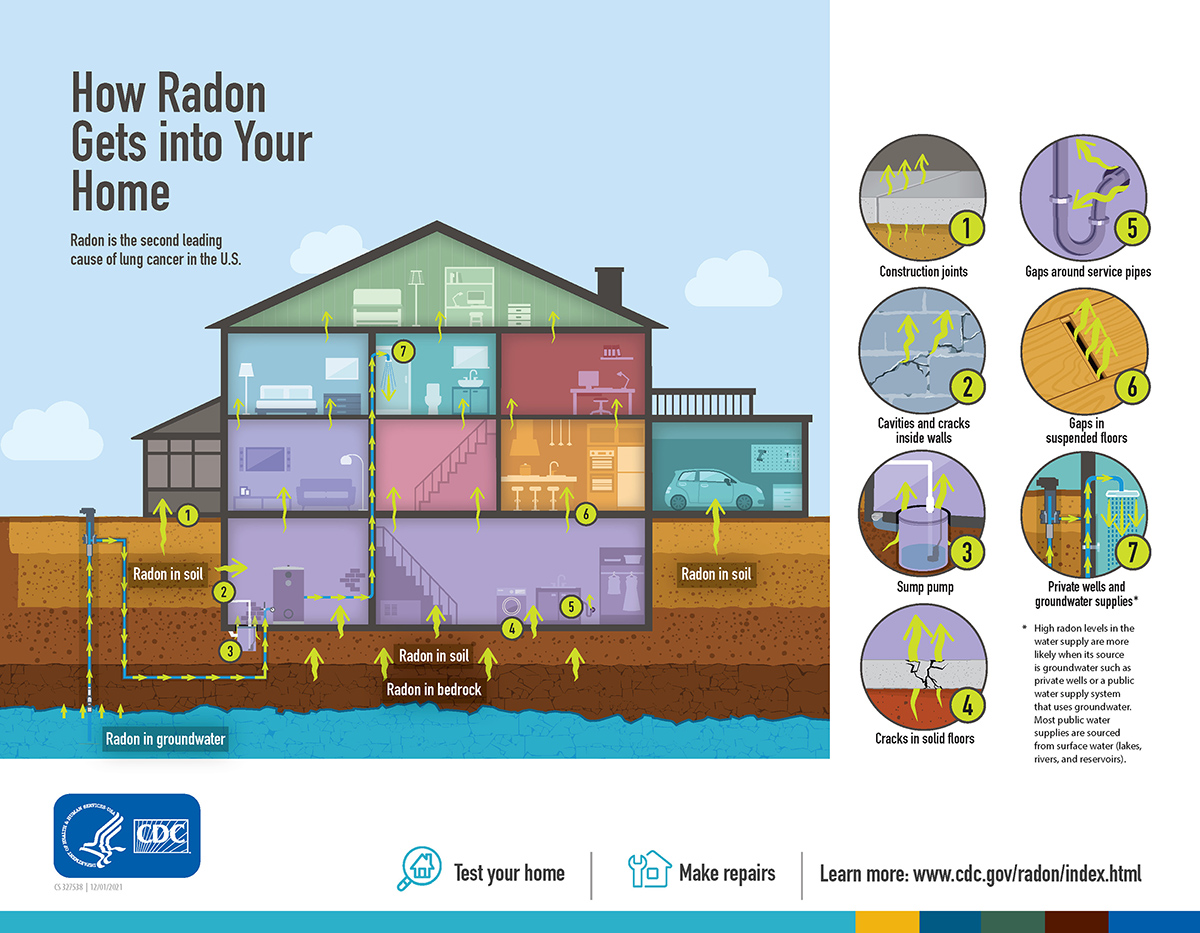Introduction
Radon

Radon
Radon is a naturally occurring radioactive gas that is colorless and odorless. Radon comes from the natural decay of uranium or thorium, elements found in rocks, soils, and water. Radon breaks down quickly, giving off radioactive particles. When inhaled, these radioactive particles can damage cells that line the lung.
Radon gas is in nearly all outdoor air but usually at low levels. Radon is also found in water. A higher radon level in the water supply is more likely when the source is ground water, such as from a private well. Most public water supplies are sourced from surface water, such as lakes, rivers, and reservoirs.
Does radon affect health?
Scientists agree that radon causes lung cancer in humans. Being exposed to radon for a long period of time can lead to lung cancer. In the U.S., radon exposure is the second leading cause of lung cancer after cigarette smoking.
Exposure to the combination of radon gas and cigarette smoke creates an even greater chance of developing lung cancer. The majority of radon-related cancer deaths occur among smokers. However, it is estimated that about 10% of radon-related cancer deaths occur among nonsmokers.
How does radon get into a building or home?
Radon gas can get trapped inside homes and buildings and accumulate in the air. Radon moves up through the ground and can enter a building through cracks in foundations, floors, or walls. It can also be released from building materials and from some ground water. Radon levels are usually highest in basements or crawl spaces. But radon can build up in the air of any home or building whether or not it is sealed or drafty or is new or older.

What can I do about radon?
It is not possible to avoid radon completely. But you can protect your health by testing for radon and taking any recommended steps to lower radon exposure in buildings or homes that have elevated levels. This process, known as radon mitigation, can lower your exposure.
To reduce the risk of lung cancer, the EPA recommends remedies for homes with radon concentrations of four or more picocuries per liter (pCi/L) of air. EPA also recommends considering repairs when radon concentrations are between two and four pCi/L.
The U.S. Department of Housing and Urban Development recommends these actions to help reduce radon levels in your home:
- Increase air flow in your house by opening windows and using fans and vents to circulate air. However, natural ventilation in any type of house is only a temporary strategy to reduce radon.
- Seal cracks in floors and walls with plaster, caulk, or other mate¬rials designed for this purpose.
- Cover an earth floor in crawl spaces with a high-density plastic sheet. A special vent pipe and fan can be used to blow the radon from under the sheet and vent it to the outdoors.
- Monitor radon levels after any fixes to ensure that radon levels are lower.
EPA provides guidance and resources for reducing radon in schools. Contact your state radon office for information about testing and reduction strategies in schools, daycare and childcare facilities, and workplaces in your area.
What is NIEHS Doing?
NIEHS supports research on exposure to radon and its health effects. Researchers are also developing ways to raise community awareness of radon risk.
Radon on the RADAR - Kentucky leads the nation in the incidence of new lung cancer cases, and researchers suspect that the individual or combined effects of tobacco smoke and radon exposure play a role. A NIEHS-funded study by the University of Kentucky, Residents Acting to Detect and Alleviate Radon (RADAR), integrates local data on bedrock geology with radon levels. Researchers use this knowledge to inform home testing and affordable mitigation efforts. The project addresses community concerns about radon intrusion into homes and raises awareness of exposure risk.
High School Students Become Citizen Scientists to Reduce Radon Exposure – In a related citizen science project, researchers at the University of Kentucky and the University of Cincinnati teamed with two high schools to conduct home radon testing. Because radon is colorless, odorless, and tasteless, it is an invisible enemy, and raising awareness about it can be tricky. This project found a promising approach to increase a community’s understanding of radon and to prompt action.
While radon has long been a noted cause of lung cancer, NIEHS-funded researchers are looking at associations with other health effects.
Research published in 2024 found exposure to higher levels of indoor radon is also associated with an increased risk of ischemic stroke in middle-age to older women. Moreover, the researchers discovered the increased risk of stroke may depend on radon-related mutations that allow certain white blood cells to rapidly multiply, a condition called clonal hematopoiesis. Future studies can further examine the stroke association to inform public health recommendations.
Another NIEHS-funded project found indoor exposure to air particles from radon decay is associated with reduced pulmonary function in COPD patients. Findings from such studies further support the need to fix homes with higher radon concentrations.
Further Reading
Podcasts
- Keeping Your Home Safe From Radon (January 2024) – Ellen Hahn, Ph.D., University of Kentucky, engages citizen scientists in rural Kentucky to test their homes for radon. Kentucky leads the nation in the incidence of new lung cancer cases, and researchers suspect that the individual or combined effects of tobacco smoke and radon exposure play a role. Hahn discusses her work to increase radon awareness and testing and help residents take action to reduce their exposure at home.
- January is National Radon Action Month (2021) – You might not think of radon as a women’s health issue. But in many ways, it is exactly that. From the NIEHS Women’s Health Awareness initiative, listen to an expert describe radon and related issues.
Additional Resources
- CDC Radon: Test Your Home – Find out about testing your home for radon. Testing is the only way to know if radon levels are high.
- EPA Map of Radon Zones – Radon levels vary across the country. This map can assist homeowners in understanding risk and governmental organizations in implementing radon-resistant building codes.
- EPA Radon Resources – Find information for individuals and families, homeowners, and builders and contractors.
- NIH Environmental Wellness Toolkit – Strategies for improving your environmental health are listed here.
- Radon and Cancer – Questions and Answers from the National Cancer Institute.
Related Health Topics
This content is available to use on your website.
Please visit NIEHS Syndication to get started.

